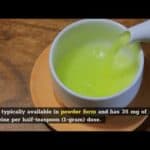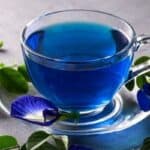Cold Brew Tea
Cold brew tea is tea that has been steeped for a lengthy amount of time…
…in cold or room temperature water. The tea leaves are brewed gently, employing time rather than warmth to unleash the flavors. The technique of cold brewing tea originated in Japan. It is said to gently remove tastes from the tea itself in Japan. Hotter brewing might burn the tea, eliminating any natural advantages and producing a bitter tea.
How To Make Cold Brew Tea
You simply need tea, cold water, and time to prepare cold brew iced tea. That’s all. Furthermore, as compared to making hot tea, the cold brew technique not only provides better balanced flavors. I guarantee that after you’ve steeped tea in cold water, you’ll never brew iced tea the same way again. The only disadvantage to making tea with cold water that I can think of is that you must prepare ahead of time. This is due to the fact that steeping tea in cold water takes at least 8-12 hours. The filtered tea can be stored in the refrigerator for many days. Overall, the method of preparing cold brew iced tea is simple and yields the greatest tasting iced tea.
Benefits of Making Tea with Cold Water
If you’re new to brewing cold brew iced tea, you’re undoubtedly curious. You may be wondering why so many people, including myself, believe that cold brew tea is the greatest way to prepare iced tea. You may also be thinking about the advantages of cold brew tea. In a nutshell, this beverage is the ideal approach since the procedures are simple, the flavor is smooth and complex, and the process may enhance certain nutritional advantages.
Easy Steps:
There’s no need to fiddle with a tea kettle or worry about correct water temps while making cold brew iced tea. Of course, excellent components are important, but obviously mixing tea and cold water in a jar and refrigerating it is extremely easy.
Improved Flavor & Profile:
Tannins and bitterness are frequently released during a hot infusion. A cold infusion, on the other hand, virtually produces a sweeter flavor. In reality, tastes that are smoother and more complex are extracted.
Enhanced Nutritional Benefits:
Here are a few of the nutritional benefits:
- Because sweet, fruity taste notes emerge during the cold brew process, consumers may choose to use less sugar in their iced tea.
- Also, did you know that cold brewing caffeinated teas yields around half the caffeine amount of a hot infusion? This might be a significant benefit for many tea drinkers. Cold-brewed teas and coffees differ chemically from their hot counterparts, containing less caffeine and less acid.
- Finally, when compared to hot tea infusions, this lengthy, cold procedure permits tea to retain the same or more antioxidant polyphenols.
Difference Between Iced Tea and Cold Brew
Before I teach you how to prepare cold brew tea, let me explain the difference between it and iced tea. The conventional hot brew process is used to make iced tea. Summer’s favorite drink is made by pouring the tea over ice. Cold brew tea, on the other hand, is made using cold water. It may also be poured over ice to make an iced tea drink. As a result, the primary distinction between iced tea and cold brew tea is the brewing method (hot or cold).
Things you Need to Make Cold Brew Iced Tea
If you’re sure that cold brewing is the best method to prepare iced tea and are ready to give it a try, here’s what you’ll need (apart from tea and water):
- Glass Jar with Lid
- Strainer or Infuser for Loose Tea
Another advantage of this simple method of making tea is that no elaborate or expensive equipment is necessary. You’ll need a glass jar with a cover at the very least, but you can be creative and use a glass measuring cup or pitcher instead. Furthermore, if you prepare cold brew tea using loose tea (the preferred method), you will need a fine mesh strainer or an infuser to pour through.
Was this helpful?
Hi there! I’m a food enthusiast and journalist, and I have a real passion for food that goes beyond the kitchen. I love my dream job and I’m lucky enough to be able to share my knowledge with readers of several large media outlets. My specialty is writing engaging food-related content, and I take pride in being able to connect with my audience. I’m known for my creativity in the kitchen, and I’m confident that I can be the perfect guide for anyone looking to take their culinary journey to the next level.









